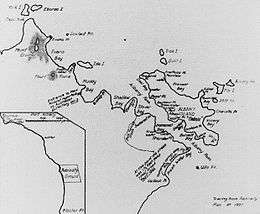Albany Island
Albany Island or Pabaju is an island at the very tip of Cape York Peninsula in the Adolphus Channel and part of the Manar Group of islands of Queensland, Australia, in the Cape York Peninsula about 20 km (12 mi) East of Bamaga, and 6 km (3.7 mi) southeast of the tip of Cape York.
| Native name: Pabaju | |
|---|---|
.png) Albany Island (Pictured in center) | |
 Admiralty Plan No. 1937. Plan drawn in 1862 showing site on Albany Island advised for the proposed Cape York Station, and the best position for the township on the mainland opposite. | |
| Geography | |
| Archipelago | Torres Strait Islands |
| Length | 6 km (3.7 mi) |
| Administration | |
The island is a part of the Torres Strait Islands; it is about 6 km (3.7 mi) long and is volcanic with fringing coral reefs.[1] It is said to have been certainly part of the territory of the Djagaraga or Gudang people.[2]
The island was surveyed very early in the region's history[3] and part of the island was named Port Albany.[4]
A bêche-de-mer station was established on the island in 1862 by C. Edwards and J. Frazer.[5] After an inspection by Queensland's Governor Bowen, a settlement was planned for the island but it was built instead on the adjacent mainland in 1863 at Somerset, Queensland. There was still a trochus shell farm there in 1995,[6] and there is now an operational pearl farm.[7]
The wreck of the RMS Quetta, a passenger ship that sank in 1890, lies just off Albany Island. The ship hit an uncharted rock and sank in a very short time killing 134 people.[8]
History
Djagaraga (also known as Yadhaigana, Dyagaraga and Yagulleone) is of the languages from the tip of Cape York. The language region includes the landscape within the local government boundaries of the Northern Peninsula Area Regional Council. Traditionally the language was spoken on Eastern Cape York particularly the localities of Albany Island and Mount Adolphus Island.[9]
Footnotes
- "Archived copy". Archived from the original on 11 July 2011. Retrieved 28 December 2010.CS1 maint: archived copy as title (link)
- Moore (1979), p. 299.
- By Captain Owen Stanley, R.N., in 1848 - http://nla.gov.au/nla.map-vn3791390
- http://www.nla.gov.au/apps/cdview?pi=nla.map-vn3791390-e
- Ganter (1994), p. 223.
- Firth & Firth (1995), pp. 16-17.
- "Cape York Fishing & Tour Guides - Cape York, Queensland Australia". www.capeyorkinfo.org.
- http://www.1300cairns.com.au/trinity_bay.html
-

References
- Bowen, George (1864). “New Settlement at Cape York, and Survey within Great Barrier Reef,” Proceedings of the Royal Geographical Society of London, Vol. 8, No. 4 (1863 - 1864), pp. 114–121.
- Firth, Dawn W. and Clifford B. (1995). Cape York Peninsula. Reed Books. ISBN 0-7301-0469-9.
- Ganter, Regina (1994). The Pearl-Shellers of Torres Strait. Melbourne University Press. ISBN 0-522-84547-9.
- Moore, David R. (1979). Islanders and Aborigines at Cape York. Australian Institute of Aboriginal Studies, Canberra. ISBN 0-85575-076-6 (hard cover); ISBN 0-85575-082-0 (soft cover). USA edition: ISBN 0-391-00946-X (hard cover); ISBN 0-391-00948-6 (soft cover).